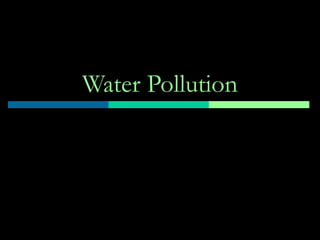
Water pollution
- 2. Definitions Impaired Waters Section 303(d) of the Clean Water Act requires states to develop lists of impaired waters, those that do not meet water quality standards that states have set for them. Total Maximum Daily Load The law requires that states establish priority rankings for impaired waters and develop total maximum daily loads (TMDLs) for them. A TMDL specifies the maximum amount of a pollutant that a body of water can receive and still meet water quality standards. http://www.epa.gov/owow/tmdl/overviewfs.html
- 3. Point Source Pollution vs. Nonpoint Source Pollution What’s the difference? Slides by Christopher C. Obropta, Rutgers University
- 4. Point Source Pollution comes from a specific source, like a pipe factories, industry, municipal treatment plants can be monitored and controlled by a permit system
- 5. What is nonpoint source pollution? Nonpoint Source (NPS) Pollution is pollution associated with stormwater or runoff NPS pollution cannot be traced to a direct discharge point such as a wastewater treatment facility
- 6. Examples of NPS oil & grease from cars sewage & cleaners from fertilizers boats animal waste household cleaning products grass clippings litter septic systems
- 7. Pollutant Transport Mechanisms • NPS pollutants build up on land surfaces during dry weather Atmospheric deposition Fertilizer applications Animal waste Automotive exhaust/fluid leaks • Pollutants are washed off land surfaces during precipitation events (stormwater runoff) • Stormwater runoff will flow to lakes and streams
- 8. Pollutant build-up and wash off are affected by land use. Imperviousness increases runoff Land use changes impact build up
- 9. Linking Land Use to Water Quality More Imperviousness = More Water
- 10. What is impervious cover? roads, rooftops, parking lots, and other hard surfaces that do not allow stormwater to soak into the ground “predominant American vegetation”
- 11. Impervious Cover • provides a surface for accumulation of pollutants • leads to increased polluted runoff and flooding • inhibits recharge of groundwater
- 12. Impact of Nonpoint Source Pollution fish and wildlife recreational water activities commercial fishing tourism drinking water quality
- 13. Pollutants Found in Runoff Sediment Biochemical Oxygen Demand (BOD) Soil particles ● Oxygen depleting material transported from Leaves their source Organic material Toxics Nutrients ● Pesticides ● Various types of materials that Herbicides become dissolved and Fungicides suspended in water (commonly Insecticides found in fertilizer and plant material): ● Metals (naturally occurring Nitrogen (N) in soil, automotive Phosphorus (P) emissions/ tires) Lead Zinc Bacteria/ Pathogens Thermal Mercury Originating from: Stress ● Petroleum Hydrocarbons ● Pets Heated runoff, (automotive exhaust and ● Waterfowl removal of fuel/oil) streamside ● Failing septic systems vegetation Debris Litter and illegal dumping
- 14. Potential Sources of Pollutants Found in Residential Areas Nutrients: Fertilizers and septic systems Pathogens: Pet waste and septic systems Sediment: Construction, road sand, soil erosion Toxic: Pesticides, household products Debris: Litter and illegal dumping Thermal: heated runoff, removal of streamside vegetation
- 15. Pollutants from Agriculture Sediment Nutrients Pathogens Pesticides
- 16. Why are these pollutants important? Sediment reduces light penetration in stream, clogs gills of fish and aquatic invertebrates. Nutrients act as fertilizer for algae & aquatic plants which can cause highly varying dissolved oxygen levels. At low DO levels, the aquatic life has the potential to be harmed. Toxics can impact life and contaminate drinking water supplies. Bacteria/Pathogens are an indicator of possible viruses present in the system.
